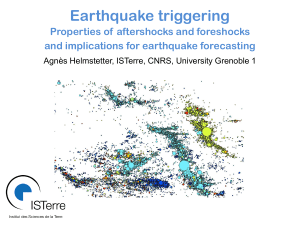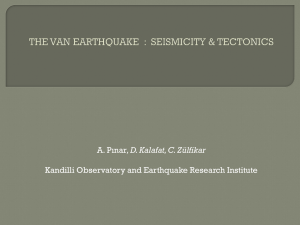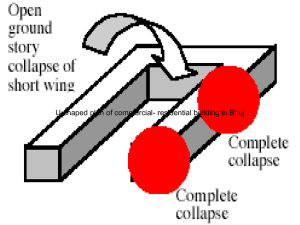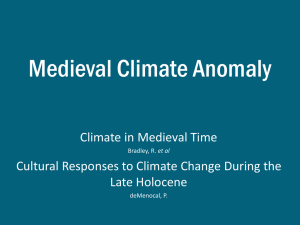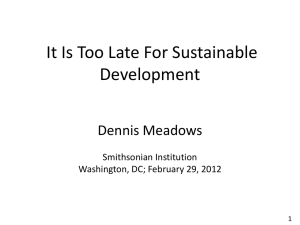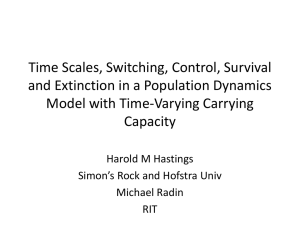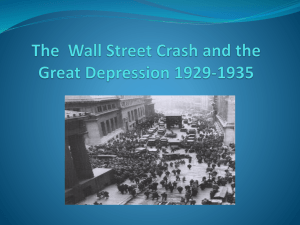Structural Collapse Capacity
advertisement
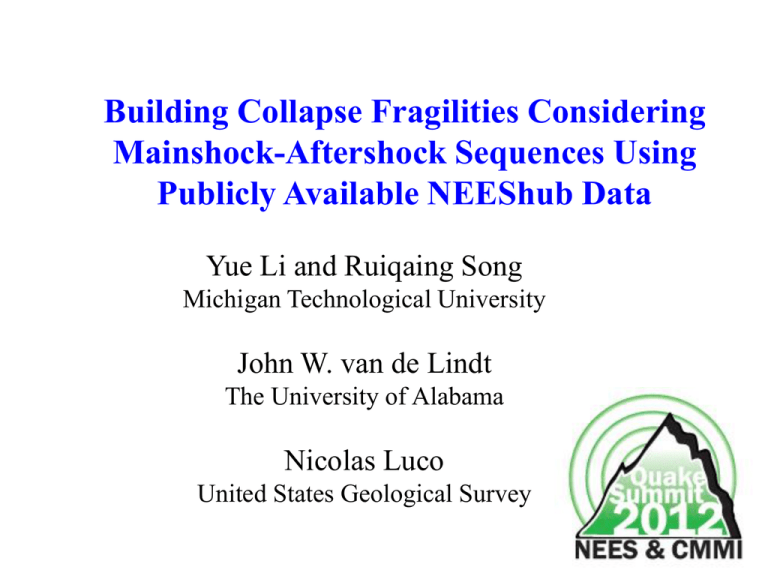
Building Collapse Fragilities Considering Mainshock-Aftershock Sequences Using Publicly Available NEEShub Data Yue Li and Ruiqaing Song Michigan Technological University John W. van de Lindt The University of Alabama Nicolas Luco United States Geological Survey 1 Integration of Mainshock-Aftershock Sequences Into Performance-Based Engineering Using Publicly Available NEEShub Data Yue Li (PI) Michigan Technological University John van de Lindt (Co-PI) University of Alabama Nicolas Luco (Co-PI) United States Geological Survey Graduate Students: Ruiqiang Song Negar Nazari NSF CMMI -1000567 Introduction • During earthquake events, it’s very common to observe many aftershocks following the mainshock (588 aftershock with magnitude 5 and greater recorded after the Earthquake in Japan 2011). Tohoku Aftershock • Although smaller in magnitude, aftershocks may have a large ground motion intensity, longer duration and different frequency content 3 Motivation • Potential to cause severe damage to buildings and threaten life safety even when only minor damage is present from the mainshock • However, most of current seismic risk assessment focus on risk due to a mainshock event only February 2011 Christchurch Earthquake 4 Research Challenges • Significant uncertainty in collapse capacity of damaged buildings after the mainshock • Characteristics of aftershocks are quite complex • Lack of system fragility models to evaluate building performance PBE objectives Design/retrofit options Task 1 Design portfolio Building No. 1 Building Type Brief Description Steel 2 Steel 3 Steel 4 Light-frame Wood Light-frame Wood Three-story steel building with ordinary moment frame Four-story steel building with special moment frame Eight-story steel building with special moment frame Two-story light commercial building Three-story apartment building 5 Pcollapse = Numerical model selection Task 2 Global-level hysteresis damage model Consider aftershock? Mainshock-aftershock sequence simulation PBE framework mainshock only Task 3 Fragility generation for degrading systems Task 4 Integration of aftershock hazard with PBE P[Collapse | S a x] | dH ( x) | Satisfied performance expectation? Task 5 Illustration and Integration into Existing Methodologies Seismic Rehabilitation of Existing Building Tested Steel Structure at NEES @ Buffalo • A typical 4-story 2-bay steel moment frame (1/8 scale) is selected (Lignos and Krawinkler 2011) 7 Calibration of Prototype and Test model Natural period in the EW direction Pushover analysis in EW direction Results T1 T2 T3 Peak based shear/weight Maximum roof drift Lignos Thesis 1.32 0.39 0.19 0.2 8.2% Centerline model 1.32 0.44 0.24 0.2 8.2% Based Shear/Weight Lignos Result: Figure 8.1 Simulation Model 0.2 0.15 0.1 0.05 0 0.00 • 0.05 Roof Drift 0.10 Probability of Exceedence Pushover Curves 0.25 Fragility Curve 1 0.8 0.6 0.4 Simulated model 0.2 Lignos's result 0 0 1 2 Sa (g) 3 4 5 The first three modal periods, pushover curve, fragility curves and time history response of prototype and test model are calibrated 8 2010 - 2011 Canterbury Earthquake Records at Resthaven, New Zealand 9 Structural Collapse Capacity • • 22 Far-Field records and 28 Near-Field records from FEMA P695 Preform incremental dynamic analysis (IDA) to determine structural collapse capacity 10 Damaged Building from Mainshock • In order to obtain the specific structural damage condition sustained from mainshock, the intensity level of mainshock is scaled to cause the following drift defined in ASCE/SEI 41-06 Damage Level Drift Immediate occupancy 0.7% transient life safety 2.5% transient collapse prevention 5% transient 11 Structural Collapse Capacity Difference Damage Level from Mainshock + Aftershock Spectral acceleration (g) IDA for different damage state from MS 2 1.8 1.6 1.4 1.2 1 0.8 0.6 0.4 0.2 0 Only Mainshock I.O.(0.7% from MS, Unchanged) + AS L.S.(2.5% from MS, Unchanged) + AS C.P.(5.0% from MS, Unchanged) + AS 0 0.05 0.1 0.15 Drift 0.2 0.25 12 Structural Collapse Capacity Difference Damage Level from Mainshock + Aftershock Spectral acceleration (g) IDA for different damage state from MS 2 1.8 1.6 1.4 1.2 1 0.8 0.6 0.4 0.2 0 Only Mainshock I.O.(0.7% from MS, Unchanged) + AS L.S.(2.5% from MS, Unchanged) + AS C.P.(5.0% from MS, Unchanged) + AS 0 0.05 0.1 0.15 Drift 0.2 0.25 13 Spectral accleration (g) Structural Collapse Capacity Mainshock Damaged Building + Different Aftershocks 2 1.8 1.6 1.4 1.2 1 0.8 0.6 0.4 0.2 0 Damaged from MS +different AS Only Mainshock MS + Scaled AS 0.25g (Unchanged) MS + Scaled AS 0.85g (Unchanged) MS + Scaled AS 1.40g (Unchanged) 0 0.05 0.1 Drift 0.15 0.2 0.25 14 Spectral accleration (g) Structural Collapse Capacity Mainshock Damaged Building + Different Aftershocks 2 1.8 1.6 1.4 1.2 1 0.8 0.6 0.4 0.2 0 Damaged from MS +different AS Only Mainshock MS + Scaled AS 0.25g (Unchanged) MS + Scaled AS 0.85g (Unchanged) MS + Scaled AS 1.40g (Unchanged) 0 0.05 0.1 Drift 0.15 0.2 0.25 15 Probability of Exceedence Collapse Fragility Curves 1.0 0.9 0.8 0.7 0.6 0.5 0.4 0.3 0.2 0.1 0.0 Only mainshock I.O.(0.7% from MS) + AS L.S.(2.5% from MS) + AS C.P.(5.0% from MS) + AS 0.0 1.0 2.0 Sa (g) 3.0 4.0 16 Combination of Mainshock-aftershock Sequences 1. Mainshock + repeated aftershock (Far-Field) 2. Mainshock + random aftershock (Far-Field) 3. Mainshock (Far-Field) + aftershock (Near-Field) 4. As-recorded mainshock + aftershock sequences 17 Collapse Capacity for MS-AS Sequences 18 Summary and On-going Research • Damaged building from mainshock may have significantly reduced collapse capacity • Structural collapse capacity depends on combination of mainshock - aftershock sequences, particularly the frequency contents in earthquake ground motions • • • Investigation of portfolio of representative steel buildings Effects of as-record MS-AS sequences to be investigated Wood frame buildings – collaborative work at University of Alabama (Prof. John van de Lindt, Co-PI) 19 Thank you! Contact Information: Dr.Yue Li Associate Professor Michigan Technological University yueli@mtu.edu


